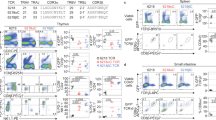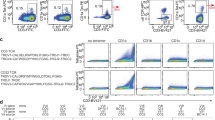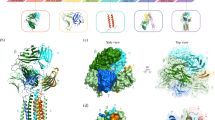Abstract
A T-cell-mediated immune response is initiated by the T-cell receptor (TCR) interacting with peptide-bound major histocompatibility complex (pMHC) on an infected cell. The mechanism by which this interaction triggers intracellular phosphorylation of the TCR, which lacks a kinase domain, remains poorly understood. Here, we have introduced the TCR and associated signalling molecules into a non-immune cell and reconstituted ligand-specific signalling when these cells are conjugated with antigen-presenting cells. We show that signalling requires the differential segregation of a phosphatase and kinase in the plasma membrane. An artificial, chemically controlled receptor system generates the same effect as TCR–pMHC, demonstrating that the binding energy of an extracellular protein–protein interaction can drive the spatial segregation of membrane proteins without a transmembrane conformational change. This general mechanism may extend to other receptors that rely on extrinsic kinases, including, as we demonstrate, chimaeric antigen receptors being developed for cancer immunotherapy.
This is a preview of subscription content, access via your institution
Access options
Subscribe to this journal
Receive 51 print issues and online access
$199.00 per year
only $3.90 per issue
Buy this article
- Purchase on Springer Link
- Instant access to full article PDF
Prices may be subject to local taxes which are calculated during checkout






Similar content being viewed by others
References
Smith-Garvin, J. E., Koretzky, G. A. & Jordan, M. S. T cell activation. Annu. Rev. Immunol. 27, 591–619 (2009)
Lemmon, M. A. & Schlessinger, J. Cell signaling by receptor tyrosine kinases. Cell 141, 1117–1134 (2010)
Palacios, E. H. & Weiss, A. Function of the Src-family kinases, Lck and Fyn, in T-cell development and activation. Oncogene 23, 7990–8000 (2004)
Love, P. E. & Hayes, S. M. ITAM-mediated signaling by the T-cell antigen receptor. Cold Spring Harb. Perspect. Biol. 2, a002485 (2010)
Au-Yeung, B. B. et al. The structure, regulation, and function of ZAP-70. Immunol. Rev. 228, 41–57 (2009)
van der Merwe, P. A. & Dushek, O. Mechanisms for T cell receptor triggering. Nature Rev. Immunol. 11, 47–55 (2011)
Xu, C. et al. Regulation of T cell receptor activation by dynamic membrane binding of the CD3ε cytoplasmic tyrosine-based motif. Cell 135, 702–713 (2008)
Davis, S. J. & van der Merwe, P. A. The kinetic-segregation model: TCR triggering and beyond. Nature Immunol. 7, 803–809 (2006)
Lillemeier, B. F. et al. TCR and Lat are expressed on separate protein islands on T cell membranes and concatenate during activation. Nature Immunol. 11, 90–96 (2010)
Varma, R., Campi, G., Yokosuka, T., Saito, T. & Dustin, M. L. T cell receptor-proximal signals are sustained in peripheral microclusters and terminated in the central supramolecular activation cluster. Immunity 25, 117–127 (2006)
Szymczak, A. L. et al. Correction of multi-gene deficiency in vivo using a single ‘self-cleaving’ 2A peptide-based retroviral vector. Nature Biotechnol. 22, 589–594 (2004)
Aleksic, M. et al. Dependence of T cell antigen recognition on T cell receptor–peptide MHC confinement time. Immunity 32, 163–174 (2010)
Holst, J. et al. Scalable signaling mediated by T cell antigen receptor-CD3 ITAMs ensures effective negative selection and prevents autoimmunity. Nature Immunol. 9, 658–666 (2008)
Irving, B. A. & Weiss, A. The cytoplasmic domain of the T cell receptor ζ chain is sufficient to couple to receptor-associated signal transduction pathways. Cell 64, 891–901 (1991)
Deindl, S. et al. Structural basis for the inhibition of tyrosine kinase activity of ZAP-70. Cell 129, 735–746 (2007)
Bergman, M. et al. The human p50csk tyrosine kinase phosphorylates p56lck at Tyr-505 and down regulates its catalytic activity. EMBO J. 11, 2919–2924 (1992)
Hermiston, M. L., Xu, Z. & Weiss, A. CD45: a critical regulator of signaling thresholds in immune cells. Annu. Rev. Immunol. 21, 107–137 (2003)
Saunders, A. E. & Johnson, P. Modulation of immune cell signalling by the leukocyte common tyrosine phosphatase, CD45. Cell. Signal. 22, 339–348 (2010)
Chen, J. L. et al. Structural and kinetic basis for heightened immunogenicity of T cell vaccines. J. Exp. Med. 201, 1243–1255 (2005)
Monks, C. R., Freiberg, B. A., Kupfer, H., Sciaky, N. & Kupfer, A. Three-dimensional segregation of supramolecular activation clusters in T cells. Nature 395, 82–86 (1998)
Altan-Bonnet, G. & Germain, R. N. Modeling T cell antigen discrimination based on feedback control of digital ERK responses. PLoS Biol. 3, e356 (2005)
Manz, B. N., Jackson, B. L., Petit, R. S., Dustin, M. L. & Groves, J. T-cell triggering thresholds are modulated by the number of antigen within individual T-cell receptor clusters. Proc. Natl Acad. Sci. USA 108, 9089–9094 (2011)
Valitutti, S., Dessing, M., Aktories, K., Gallati, H. & Lanzavecchia, A. Sustained signaling leading to T cell activation results from prolonged T cell receptor occupancy. Role of T cell actin cytoskeleton. J. Exp. Med. 181, 577–584 (1995)
Johnson, K. G., Bromley, S. K., Dustin, M. L. & Thomas, M. L. A supramolecular basis for CD45 tyrosine phosphatase regulation in sustained T cell activation. Proc. Natl Acad. Sci. USA 97, 10138–10143 (2000)
Leupin, O., Zaru, R., Laroche, T., Muller, S. & Valitutti, S. Exclusion of CD45 from the T-cell receptor signaling area in antigen-stimulated T lymphocytes. Curr. Biol. 10, 277–280 (2000)
Irles, C. et al. CD45 ectodomain controls interaction with GEMs and Lck activity for optimal TCR signaling. Nature Immunol. 4, 189–197 (2003)
He, X., Woodford-Thomas, T. A., Johnson, K. G., Shah, D. D. & Thomas, M. L. Targeting of CD45 protein tyrosine phosphatase activity to lipid microdomains on the T cell surface inhibits TCR signaling. Eur. J. Immunol. 32, 2578–2587 (2002)
Choudhuri, K., Wiseman, D., Brown, M. H., Gould, K. & van der Merwe, P. A. T-cell receptor triggering is critically dependent on the dimensions of its peptide-MHC ligand. Nature 436, 578–582 (2005)
Porter, D. L., Levine, B. L., Kalos, M., Bagg, A. & June, C. H. Chimeric antigen receptor-modified T cells in chronic lymphoid leukemia. N. Engl. J. Med. 365, 725–733 (2011)
Shaw, A. S. & Dustin, M. L. Making the T cell receptor go the distance: a topological view of T cell activation. Immunity 6, 361–369 (1997)
Qi, S. Y., Groves, J. T. & Chakraborty, A. K. Synaptic pattern formation during cellular recognition. Proc. Natl Acad. Sci. USA 98, 6548–6553 (2001)
Weikl, T. R. & Lipowsky, R. Pattern formation during T-cell adhesion. Biophys. J. 87, 3665–3678 (2004)
Coombs, D., Dembo, M., Wofsy, C. & Goldstein, B. Equilibrium thermodynamics of cell–cell adhesion mediated by multiple ligand–receptor pairs. Biophys. J. 86, 1408–1423 (2004)
Alakoskela, J. M. et al. Mechanisms for size-dependent protein segregation at immune synapses assessed with molecular rulers. Biophys. J. 100, 2865–2874 (2011)
Burroughs, N. J. & Wulfing, C. Differential segregation in a cell–cell contact interface: the dynamics of the immunological synapse. Biophys. J. 83, 1784–1796 (2002)
Yokosuka, T. et al. Newly generated T cell receptor microclusters initiate and sustain T cell activation by recruitment of Zap70 and SLP-76. Nature Immunol. 6, 1253–1262 (2005)
Campi, G., Varma, R. & Dustin, M. L. Actin and agonist MHC–peptide complex-dependent T cell receptor microclusters as scaffolds for signaling. J. Exp. Med. 202, 1031–1036 (2005)
Bunnell, S. C. et al. T cell receptor ligation induces the formation of dynamically regulated signaling assemblies. J. Cell Biol. 158, 1263–1275 (2002)
Acknowledgements
We thank A. van der Merwe and V. Cerundolo for the 1G4 TCR sequence, A. Weiss for cell lines and advice, C. June for the CD19 CAR construct, N. Stuurman and K. Thorn for microscopy help and members of the Vale laboratory for discussions. R.D.V. is a Howard Hughes Medical Institute investigator and J.R.J. is a fellow of the Jane Coffin Childs Memorial Fund.
Author information
Authors and Affiliations
Contributions
J.R.J. conceived the study, collected the data and conducted the analyses. J.R.J. and R.D.V. designed the experiments and wrote the manuscript.
Corresponding author
Ethics declarations
Competing interests
The authors declare no competing financial interests.
Supplementary information
Supplementary Information
This file contains Supplementary Figures 1-8 and the legends to Supplementary Movies 1-5. (PDF 2624 kb)
Supplementary Movie 1
The movie shows that the pervanadate treatment of reconstituted cells causes ZAP70 membrane recruitment - see Supplementary Information file for full legend. (AVI 110 kb)
Supplementary Movie 2
This movies contains a 3D reconstruction of the HEK-1G4:APC conjugate - see Supplementary Information file for full legend. (AVI 1710 kb)
Supplementary Movie 3
In this movie we see that ZAP70 rapidly translocates to the cell-cell interface on TCR/pMHC binding - see Supplementary Information file for full legend. (AVI 2432 kb)
Supplementary Movie 4
In this movie shows monitoring ZAP70 recruitment to signalling-competent regions with time - see Supplementary Information file for full legend. (AVI 988 kb)
Supplementary Movie 5
This movie shows that chimaeric-antigen receptor triggering can lead to extensive convolution of the HEK plasma membrane- see Supplementary Information file for full legend. (AVI 1321 kb)
Rights and permissions
About this article
Cite this article
James, J., Vale, R. Biophysical mechanism of T-cell receptor triggering in a reconstituted system. Nature 487, 64–69 (2012). https://doi.org/10.1038/nature11220
Received:
Accepted:
Published:
Issue Date:
DOI: https://doi.org/10.1038/nature11220
This article is cited by
-
Circulating tumor cells shielded with extracellular vesicle-derived CD45 evade T cell attack to enable metastasis
Signal Transduction and Targeted Therapy (2024)
-
Cell volume controlled by LRRC8A-formed volume-regulated anion channels fine-tunes T cell activation and function
Nature Communications (2023)
-
Membrane-anchored DNA nanojunctions enable closer antigen-presenting cell–T-cell contact in elevated T-cell receptor triggering
Nature Nanotechnology (2023)
-
INPP5E regulates CD3ζ enrichment at the immune synapse by phosphoinositide distribution control
Communications Biology (2023)
-
CD33 BiTE® molecule-mediated immune synapse formation and subsequent T-cell activation is determined by the expression profile of activating and inhibitory checkpoint molecules on AML cells
Cancer Immunology, Immunotherapy (2023)
Comments
By submitting a comment you agree to abide by our Terms and Community Guidelines. If you find something abusive or that does not comply with our terms or guidelines please flag it as inappropriate.



